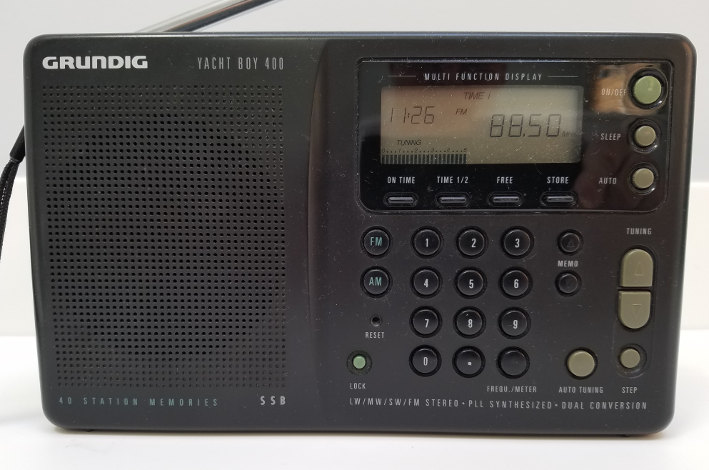
Introduced in 1993, the Grundig Yacht Boy 400 represented a set of capabilities that, for its time, represented a very good balance between performance and price. Retailing at the time for around $200 in the United States (equivalent in 2020 to $350), this radio, which I would classify both as a vintage radio and as a travel portable though it seems rather large by modern standards, was named the "Best Shortwave Portable of 1994" by the World Radio-TV Handbook in its 1995 edition. The WRTH described it in these words:
The Yacht Boy 400 is an excellent performer for a reasonable price, offering tuning convenience as well as good audio quality. This is the best value portable on the world market. (page 581)
The closest modern equivalent in my set of radios is the Digitech AR-1780, digitally tuned and offering single-sideband (SSB) reception, as does the Yacht Boy 400. While the Yacht Boy 400 is tuned with a digital synthesizer, it is not a radio that uses digital signal processing (DSP). Notably, the 1995 WRTH also included a review of one of the first DSP-based receivers, the Watkins Johnson HF-1000, which cost $4,000 in 1994. The WRTH correctly said that it was "the window on tomorrow's technology", but probably didn't forsee the sheer number of DSP-based radios, at much lower prices, that started appearing in 2008 and 2009.
And so it appears that, 25 years after the Yacht Boy 400 was produced, you can get much the same thing for what amounts to a third of the cost (adjusted for inflation) with the Digitech AR-1780 or its near-identical twin, the XHDATA D-808.
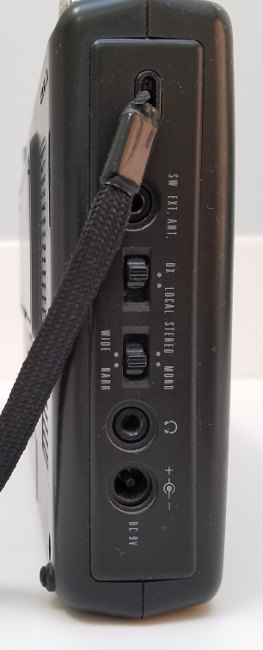
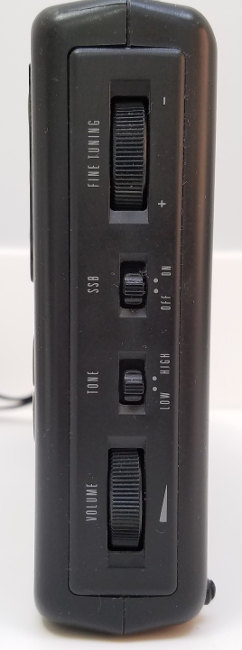
That said, the Yacht Boy 400 is packed with features and controls, as you can see from pictures of the left and right sides of the unit.
The left side (far left) features, from top to bottom:
- A jack for an external antenna for shortwave reception
- A "DX-Local" switch to adjust the receiver's sensitivity
- A dual-purpose switch for either bandwidth selection (for AM bands) or selecting between mono and stereo reception (for the FM band)
- A stereo headphone jack
- An older-style jack to support a nine-volt external power supply
The radio runs on six "AA" batteries. While the radio supports an external power adapter, one was not supplied with the radio.
On the right side (near left), the line-up goes, from top to bottom:
- A fine-tuning thumbwheel for use in SSB reception
- A switch to turn SSB reception on or off
- A high-low tone switch
- A thumbwheel to adjust the audio output volume
The AM button on the front toggles among mediumwave reception (what Americans call "AM"), longwave reception, and shortwave reception. The FM button, as you would expect, selects FM-band reception.
The radio can be tuned either by directly entering the frequency of the desired station, followed by pressing the FREQU/METER button, or by using the "up" and "down" buttons to step through the band that's been selected. For AM (mediumwave) band reception, the default step is 9 kHz. To use the Western Hemisphere standard of 10 kHz, one must:
- Turn the radio off.
- Press the AM button.
- Immediately press the STEP button.
To switch back to 9 kHz tuning steps, repeat the procedure. When the radio is on, the STEP button toggles between 1 kHz tuning steps and either 9 or 10 kHz steps. FM stations are always tuned in 50 kHz (0.05 MHz) steps. Thus, in North America, to tune up and down the FM dial requires four key presses to get to the next station.
Also for FM reception, you must include the decimal point in the station's frequency. Otherwise, the radio will also switch to one of the AM bands. For example, to tune to KQED-FM in San Francisco, you would enter: 8, 8. decimal point, 5, followed by the FREQU/METER button. If you just enter; 8, 8, 5, FREQU/METER, the radio will think you're trying to tune to a station on 885 kHz in the mediumwave AM band. It also works in the other direction: if you're listening on one of the AM bands and enter a frequency with the decimal point, the radio will tune to the FM band if that frequency exists there. This actually makes sense once you think about it, but the current generation of DSP radios don't work that way, and also don't include a separate button for the decimal point.
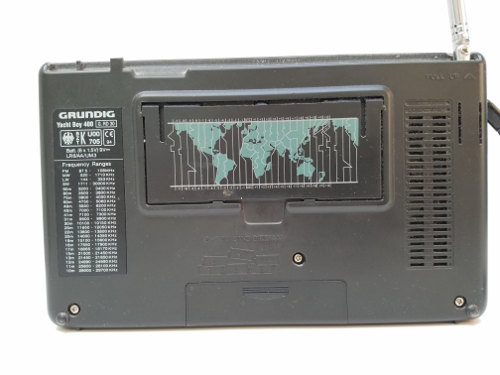
Stations can also be stored in memory, with up to 40 frequencies supported.
On a current DSP radio, many of these functions would be controlled from the front keypad. On the Yacht Boy 400, the front keypad is used mostly for tuning, band selection, and time and alarm functions.
The back of the radio (right) shows the frequency bands that it supports, as well as a map of time zones (which doubles as a stand), and the battery compartment.
By the way, seeing the photo of the back of the radio might make you think it's medium-gray in color. This radio is actually black: my camera's automatic exposure tended to flatten the contrast. I decided to leave it that way so that you could read the labels for the unit's various controls. The effect is less pronounced in the other photos.
The inclusion of a tone control (albeit with just two positions) is a nice addition and shows some attention to the radio's audio quality. When using the built-in speaker, the sound quality is much better compared to most current-day DSP-based radios. Then again, this is a larger unit that features a speaker with a diameter of 2 3/4 inches (70 mm). The Yacht Boy 400 is also heavier than the current crop of travel-sized radios, in part because of the need for more batteries.
Sound through the Yacht Boy 400's speaker has a rich and pleasant tone. Stereo headphones are supported, and FM broadcasts can be received in stereo. While relatively pleasant, the Yacht Boy's sound quality for AM signals definitely is not high fidelity. In addition to the high-low tone control, there is a bandwidth control for AM reception. For AM reception, a narrower bandwidth improves selectivity at the expense of frequency response. Clearly, Grundig's designers prioritized selectivity, which was a reasonable thing to do in a radio designed before the current era of DSP-based receivers.
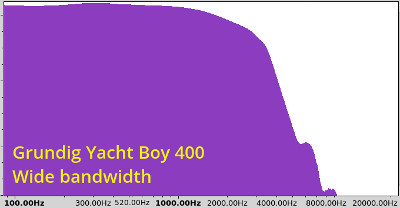
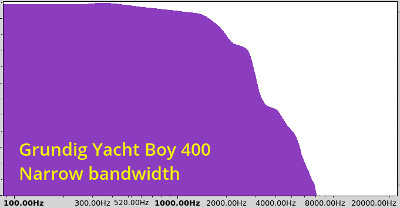
The 1995 WRTH review includes a measurement of the two bandwidths, noting that both curves were fairly sharp, with response down 6 dB at 5.5 kHz in the wide bandwidth position and 3 kHz in the narrow position. This was at variance with what I've observed from the radio. My own measurements, which admittedly are much cruder than those the WRTH could obtain from its professional test equipment, more closely match what I have heard, both through the speaker and through headphones. My measurements indicate that response is down 6 dB at 2 kHz in the wide position (left) and 1.5 kHz in the narrow position (right). The wideband filter begins to inflect sharply downward starting at 3.3 kHz and is down 40 dB at 4.7 kHz. (Note: I verified that I had the tone control in the "high", or flat, position during these measurements.)
Measurement of the narrow filter gave strange results. There did not appear to be a sharp inflection point as there was with the wide filter. Instead, there were two "shelves" where frequency response remained steady for two intervals. One such interval was between 2.2 and 2.7 kHz and the other was between 3.5 and 4 kHz. That latter "shelf" indicated a response down by 39 dB. I couldn't believe what I was seeing on the spectrum analysis of the sweep tone I used, so I repeated the test on a subsequent day, and got the same results!
Many DSP-based radios offer a wider choice of AM bandwidths, including a 6 kHz setting that vastly improves the quality of AM sound. You still wouldn't mistake it for FM, but it's better than you might otherwise think. The Yacht Boy 400 is of an earlier generation where AM bandwidth tended to be restricted to improve selectivity, and where options were more limited due to cost.
The tone control is a treble-cut switch. The "high" position allows a flat frequency response. The "low" position starts reducing higher frequencies at 400 Hz. Frequency response in the "low" position is down 6 dB at 2 kHz, 10 dB at 4 kHz, and 16 dB at 8 kHz.
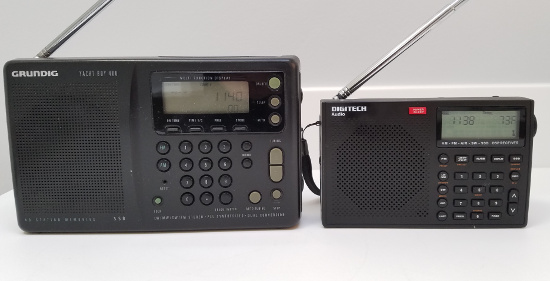
While the Yacht Boy 400's audio quality stacks up favorably compared to the DSP-based models currently available, how does it compare as far as reception of signals is concerned? To answer that question, we first have to consider which of the current DSP-based models is most comparable to the 1990's Grundig model. As mentioned in the start of this review, I settled on the Digitech AR-1780 (the smaller radio shown in the photo at left) because it features SSB reception, as does the Yacht Boy, has multiple bandwidths for AM reception, and has better audio quality than some other current models. However, it's not the top FM performer that I have. So, for better FM performance comparisons, I also included the Tecsun PL-380, which is one of the best FM performers that I have.
For FM performance comparisons, the Digitech and Tecsun models are operating under a slight disadvantage because their antennas are not properly sized for FM reception. They can't be extended far enough to reach the proper 30-inch length. The Yacht Boy 400's antenna can be extended to about 36 inches (93 mm), and so the antenna can be (and should be) extended only to 30 inches when used to pick up FM stations. That was done for this test.
As usual in my reviews, I did not compare shortwave performance, only mediumwave (AM) performance and FM performance. Longwave performance could not be compared due to the absence of longwave broadcasting in the Western Hemisphere.
The LOCAL/DX switch seemed to have the opposite effect on AM compared to FM! I had assumed that, on FM, that switch would be used in the LOCAL position to reduce the signal strength coming from the antenna in order to avoid front-end overload. The 1995 WRTH review alludes to the Yacht Boy's performance in areas with a lot of signals in a manner that indicates there could be a problem:
The sensitivity on FM is about right for Europe, but may be a little too sensitive for cities in North America where the FM dial is crowded. (page 582)
In my testing, in the San Francisco Bay Area, I found that the Yacht Boy wasn't as selective as present-day DSP-based radios, but the reality was that it was almost as sensitive as DSP-based radios. It missed only five signals that the Digitech AR-1780 and Tecsun PL-380 picked up. It also seemed more sensitive with the DX/LOCAL switch in the LOCAL position! There were at least five stations where I got better reception with the Yacht Boy with the switch in the LOCAL position. In addition, the threshold for stereo reception for the Yacht Boy is set relatively low. As I've mentioned in other reviews on this site, some DSP-radios seem to set their stereo thresholds very high, probably to avoid the added noise that is present when weaker stereo signals are decoded. This is true of the Digitech AR-1780, the nearly identical XHDATA-D808, and the Sangean DT-800. The Tecsun PL-380 and related radios seem to be more tolerant of noisy stereo reception.
In any event, the Yacht Boy 400's FM performance was just a little bit weaker than the Digitech AR-1780 or Tecsun PL-380, but I would still categorize it as very good. Not excellent, but very good.
On the AM band, the LOCAL/DX switch did not appear to affect sensitivity or selectivity. Instead, when in the DX position, the radio really cranked up its automatic gain control to make weaker signals sound almost as loud as local signals. Sensitivity was nearly identical to both the Digitech AR-1780 and the Tecsun PL-380, except in the lower part of the AM dial, where the Yacht Boy was slightly weaker. Again, the conclusion is that the Yacht Boy 400 wasn't an excellent performer, but it was a very good performer on the AM band.
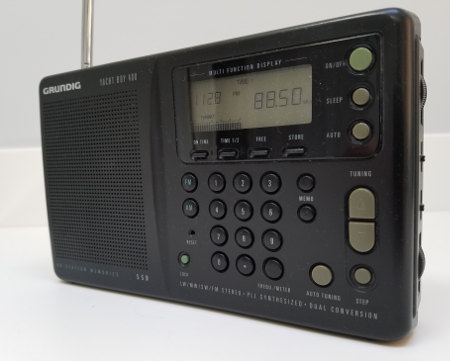
I haven't been able to determine when the Yacht Boy 400 was discontinued. Moreover, there were at least two versions of it. One was called the "early version" or "early edition". I believe this is the version I've reviewed here. The later version was called the "Professional Edition" and had a silver (or "titanium") finish. The Professional Edition appears to have been available through the early 2000's. Often you'll see it listed as the Yacht Boy 400PE.
At the time this review was written in 2020, prices for used Yacht Boy 400's were all over the place, ranging from $65 to more than $200. The 400PE model appears to be more readily available than the "early edition".
To conclude, the Yacht Boy 400 was not a top performer, but still a very good one. By modern standards, it's really too big and heavy to be considered easily portable. But it is still portable, and that larger size permits the use of a larger speaker for richer sound.